Reclaimed Area Land Cover Mapping Using Sentinel-2 Imagery and LiDAR Point Clouds
Abstract
1. Introduction
2. Data and Methods
- Sentinel-2 satellite image, 8 August 2016 (source: ESA): blue, green, and red (B,G,R) and NIR channels, spatial resolution of 10 m;
- Airborne laser scanning (ALS) point clouds, 2012 (source: Main Office of Surveying and Cartography, ISOK project—IT System for Protection of the Country, Poland), point cloud density of 6 pts/m2;
- Cadastral data, 2016 (source: Geoportal and webEWID portal).
3. Results
3.1. Machów Sulfur Mine
3.2. Jeziórko Sulfur Mine
4. Discussion
5. Conclusions
Author Contributions
Funding
Conflicts of Interest
References
- Szostak, M.; Wężyk, P.; Tompalski, P. Aerial orthophoto and airborne laser scanning as monitoring tools for land cover dynamics: A case study from the Milicz Forest District (Poland). Pure Appl. Geophys. 2014, 171, 857–866. [Google Scholar] [CrossRef]
- Szostak, M.; Bednarski, A.; Wężyk, P. Monitoring of secondary forest succession on abandoned farmland using LiDAR point clouds. Geod. Cartogr. 2018, 67, 305–319. [Google Scholar] [CrossRef]
- Susyan, E.A.; Wirth, S.; Ananyeva, N.D.; Stolnikova, E.V. Forest succession on abandoned arable soils in European Russia − Impacts on microbial biomass, fungal-bacterial ratio, and basal CO2 respiration activity. Eur. J. Soil Biol. 2011, 47, 169–174. [Google Scholar] [CrossRef]
- Bork, E.; Su, J. Integrating LIDAR data and multispectral imagery for enhanced classification of rangeland vegetation: A meta-analysis. Remote Sens. Environ. 2007, 111, 11–24. [Google Scholar] [CrossRef]
- Lasanta, T.; Arnáez, J.; Pascual, N.; Ruiz-Flaño, P.; Errea, M.P.; Lana-Renault, N. Space–time process and drivers of land abandonment in Europe. Catena 2017, 149, 810–823. [Google Scholar] [CrossRef]
- Singh, K.; Vogler, J.; Shoemaker, D.; Meentemeyer, R. LiDAR-Landsat data fusion for large-area assessment of urban land cover: Balancing spatial resolution, data volume, and mapping accuracy. ISPRS J. Photogramm. Remote Sens. 2012, 74, 110–121. [Google Scholar] [CrossRef]
- Koska, B.; Jirkab, V.; Urbana, R.; Kremena, T.; Hesslerovab, P.; Jona, J.; Pospisila, J.; Fogl, M. Suitability, characteristics, and comparison of an airship UAV with lidar for middle size area mapping. Int. J. Remote Sens. 2017, 38, 2973–2990. [Google Scholar] [CrossRef]
- Pitblado, J.R.; Amiro, B.D. Landsat Mapping of the Industrially Disturbed Vegetation Communities of Sudbury, Canada. Can. J. Remote Sens. 2014, 8, 17–28. [Google Scholar] [CrossRef]
- Urban, R.; Koska, B.; Moudry, V.; Solsky, M. Terrain of post mining site from airship lidar. In Proceedings of the 16th International Multidisciplinary Scientific GeoConference, SGEM2016, Albena, Bulgaria, 30 June–6 July 2016; Volume 2, pp. 577–584. [Google Scholar] [CrossRef]
- Wang, J.; Wei, Z.; Wang, O. Evaluating the eco-environment benefit of land reclamation in the dump of an opencast coal mine. Chem. Ecol. 2017, 33, 607–624. [Google Scholar] [CrossRef]
- Szostak, M.; Knapik, K.; Likus-Cieślik, J.; Wężyk, P.; Pietrzykowski, M. Fusing Sentinel-2 imagery and ALS Point Clouds for Defining the LULC Changes Ongoing on Reclaimed Areas by Afforestation. Sustainability 2019, 11, 1251. [Google Scholar] [CrossRef]
- Szostak, M.; Likus-Cieślik, J.; Knapik, K.; Wężyk, P.; Pietrzykowski, M. Monitoring the spatial range of forested areas in the reclaimed sites using Sentinel−2 images. Sylwan 2019, 163, 55–61. [Google Scholar]
- Szostak, M.; Wężyk, P.; Hawryło, P.; Pietrzykowski, M. The analysis of spatial and temporal changes of land cover and land use in the reclaimed areas with the application of airborne orthophotomaps and LANDSAT images. Geod. Cartogr. 2015, 64, 75–86. [Google Scholar] [CrossRef]
- Wężyk, P.; Szostak, M.; Krzaklewski, W.; Pająk, M.; Pierzchalski, M.; Szwed, P.; Hawryło, P.; Ratajczak, M. Landscape monitoring of post-industrial areas using LiDAR and GIS technology. Geod. Cartogr. 2015, 64, 125–137. [Google Scholar] [CrossRef]
- Yuan, Y.; Zhao, Z.; Niu, S.; Li, X.; Wang, Y.; Bai, Z. Reclamation promotes the succession of the soil and vegetation in opencast coal mine: A case study from Robinia pseudoacacia reclaimed forests, Pingshuo mine, China. Catena 2018, 165, 72–79. [Google Scholar] [CrossRef]
- Krzaklewski, W.; Pietrzykowski, M. Selected physicochemical properties of zinc and lead ore tailings and their biological stabilisation. Water Air Soil Pollut. 2002, 141, 125–142. [Google Scholar] [CrossRef]
- Krzaklewski, W.; Barszcz, J.; Małek, S.; Kozioł, K.; Pietrzykowski, M. Contamination of forest soils in the vicinity of the sedimentation pond after zinc and lead ore flotation (in the region of Olkusz, Southern Poland). Water Air Soil Pollut. 2004, 159, 151–164. [Google Scholar] [CrossRef]
- Kowalik, S. Właściwości chemiczne gleb industrioziemnych użytkowanych rolniczo i leśnie na zrekultywowanym zwałowisku Kopalni Siarki Machów. Rocz. Glebozn. 2004, 55, 239–249. [Google Scholar]
- Florentine, S.K.; Gardner, J.; Graz, F.P.; Moloney, S. Plant recruitment and survival as indicators of ecological restoration success in abandoned pasture land in Nurcoung, Victoria, Australia. Ecol. Process. 2013, 2, 34. [Google Scholar] [CrossRef]
- Hüttl, R.F.; Weber, E. Forest ecosystem development in post-mining landscapes, a case study of the Lusatian lignite district. Naturwissenschaften 2001, 88, 322–329. [Google Scholar]
- Pietrzykowski, M. Soil and plant communities development and ecological effectiveness of reclamation on a sand mine cast. J. For. Sci. 2008, 54. [Google Scholar] [CrossRef]
- Favas, P.J.C.; Martino, L.E.; Prasad, M.N.V. Abandoned Mine Land Reclamation—Challenges and Opportunities (Holistic Approach). In Bio-Geotechnologies for Mine Site Rehabilitation; Prasad, M.N., Favas, P.J.C., Maiti, S.K., Eds.; Elsevier: Amsterdam, The Netherlands, 2018; pp. 3–31. [Google Scholar]
- Alvarenga, P.; Clemente, R.; Garbisu, C.; Becerril, J.M. Indicators for monitoring mine site rehabilitation. In Bio-Geotechnologies for Mine Site Rehabilitation; Prasad, M.N., Favas, P.J.C., Maiti, S.K., Eds.; Elsevier: Amsterdam, The Netherlands, 2018; pp. 49–66. [Google Scholar]
- Gatica-Saavedra, P.; Echeverría, C.; Nelson, C.R. Ecological indicators for assessing ecological success of forest restoration: A world review. Restor. Ecol. 2017, 25, 850–857. [Google Scholar] [CrossRef]
- Borisev, M.; Pejevic, S.; Nikolic, N.; Pilipovic, A.; Arsenov, D.; Zupunski, M. Mine site restoration using silvicultural approach. In Bio-Geotechnologies for Mine Site Rehabilitation; Prasad, M.N., Favas, P.J.C., Maiti, S.K., Eds.; Elsevier: Amsterdam, The Netherlands, 2018; pp. 115–127. [Google Scholar]
- Pietrzykowski, M.; Krzaklewski, W. An assessment of energy efficiency in reclamation to forest. Ecol. Eng. 2007, 30, 341–348. [Google Scholar] [CrossRef]
- Huang, L.; Zhang, P.; Hu, Y.; Zhao, Y. Vegetation and soil restoration in refuse dumps from open pit coal mines. Ecol. Eng. 2016, 94, 638–646. [Google Scholar] [CrossRef]
- Bradshaw, A.D.; Hüttl, R. Future Minesite Restoration Involves a Broader Approach. Ecol. Eng. 2001, 17, 87–90. [Google Scholar] [CrossRef]
- Pietrzykowski, M. Tree species selection and reaction to mine soil reconstructed at reforested post-mine sites: Central and eastern European experiences. Ecol. Eng. 2019, 10. [Google Scholar] [CrossRef]
- Pietrzykowski, M. Soil quality index as a tool for Scots pine (Pinus ylvestris) monoculture conversion planning on afforested, reclaimed mine land. J. For. Res. 2014, 25, 63–74. [Google Scholar] [CrossRef]
- Szostak, M.; Hawryło, P.; Piela, D. Using of Sentinel-2 images for automation of the forest succession detection. Eur. J. Remote Sens. 2018, 51, 142–149. [Google Scholar] [CrossRef]
- Forkuor, G.; Dimobe, K.; Serme, I.; Tondoh, J.E. Landsat-8 vs. Sentinel-2: Examining the added value of Sentinel-2’s red-edge bands to land-use and land-cover mapping in Burkina Faso. Gisci. Remote Sens. 2018, 55, 331–354. [Google Scholar] [CrossRef]
- Marangoz, A.M.; Sekertekin, A.; Akçin, H. Analysis of land use land cover classification results derived from Sentinel-2 image. In Proceedings of the 17th International Multidisciplinary Scientific GeoConference Surveying Geology and Mining Ecology Management, SGEM2017, Vienna, Austria, 27–29 November 2017; pp. 25–32. [Google Scholar]
- Sekertekin, A.; Marangoz, A.M.; Akcin, H. Pixel-based classification analysis of land use land cover using Sentinel-2 and Landsat-8 data. Int. Arch. Photogramm. Remote Sens. Spat. Inf. Sci. 2017, 42, 91–93. [Google Scholar] [CrossRef]
- van Ewijk, K.Y.; Treitz, P.M.; Scott, N.A. Characterizing forest succession in central Ontario using lidar-derived indices. Photogramm. Eng. Remote Sens. 2011, 77, 261–269. [Google Scholar] [CrossRef]
- Falkowski, M.; Jeffrey, S.; Evans, J.; Martinuzzi, S.; Gessler, P.; Hudak, A. Characterizing forest succession with lidar data: An evaluation for the Inland Northwest, USA. Remote Sens. Environ. 2009, 113, 946–956. [Google Scholar] [CrossRef]
- Kolecka, N.; Kozak, J.; Kaim, D.; Dobosz, M.; Ginzler, C.; Psomas, A. Mapping secondary forest succession on abandoned agricultural land with LiDAR point clouds and terrestrial photography. Remote Sens. 2015, 7, 8300–8322. [Google Scholar] [CrossRef]
- Kolecka, N. Height of Successional Vegetation Indicates Moment of Agricultural Land Abandonment. Remote Sens. 2018, 10, 1568. [Google Scholar] [CrossRef]
- Szostak, M.; Wężyk, P.; Király, G.; Hawryło, P.; Bednarski, A. Automation in the assessment of forest succession dynamics using airborne laser scanning data. In Proceedings of the 18th International Multidisciplinary Scientific GeoConference Surveying Geology and Mining Ecology Management SGEM 2018, Albena, Bulgaria, 30 June–9 July 2018; Volume 18, pp. 41–48. [Google Scholar] [CrossRef]
- Axelsson, P. DEM generation from laser scanner data using adaptive TIN models. Int. Arch. Photogramm. Remote Sens. 2000, 33, 203–210. [Google Scholar]
- Andersen, H.E.; Reutebuch, S.E.; McGaughey, R.J. A rigorous assessment of tree height measurements obtained using airborne lidar and conventional field methods. Can. J. Remote Sens. 2006, 32, 355–366. [Google Scholar] [CrossRef]
- Hyyppä, J.; Hyyppä, H.; Litkey, P.; Yu, X.; Haggrén, H.; Rönnholm, P.; Pyysalo, U.; Pitkanen, J.; Maltamo, M. Algorithms and methods of airborne laser-scanning for forest measurements. Int. Arch. Photogramm. Remote Sens. Spat. Inf. Sci. 2004, 8, 82–89. [Google Scholar]
- Maier, B.; Tiede, D.; Dorren, L. Characterising mountain forest structure using landscape metrics on LIDAR-based canopy surface models. In Lecture Notes in Geoinformation and Cartography, Object-Based Image Analysis; Springer: Berlin/Heidelberg, Germany, 2008; pp. 625–643. [Google Scholar] [CrossRef]
- McGaughey, R.J.; Carson, W.; Reutebuch, S.; Andersen, H.E. Direct measurement of individual tree characteristics from lidar data. In Proceedings of the Annual ASPRS Conference. Denver. American Society of Photogrammetry and Remote Sensing, Denver, CO, USA, 23–28 May 2004. [Google Scholar]
- Naesset, E. Predicting forest stand characteristics with airborne scanning laser using a practical two-stage procedure and field data. Remote Sens. Environ. 2002, 80, 80–99. [Google Scholar] [CrossRef]
- Naesset, E.; Okland, T. Estimating tree height and tree crown properties using airborne scanning laser in a boreal nature reserve. Remote Sens. Environ. 2002, 79, 105–115. [Google Scholar] [CrossRef]
- Wężyk, P.; Szostak, M.; Tompalski, P.; Zajączkowski, G. The role of Airborne Laser Scanning in updating and revision of GIS databases − A case study in the Polish State Forest (Chojna District). In Proceedings of the Silvilaser, 10th International Conference on LiDAR Applications for Assessing Forest Ecosystems, Freiburg, Germany, 14th–17th September 2010. [Google Scholar]
- Wężyk, P.; Tompalski, P.; Szostak, M.; Glista, M.; Pierzchalski, M. Describing the selected canopy layer parameters of the Scots pine stands using ALS data. In Proceedings of the SiliviLaser 2008: 8th International Conference on LiDAR Applications in Forest Assessment and Inventory, Edinburgh, UK, 17–19 September 2008; pp. 636–645. [Google Scholar]
- Katzur, J.; Haubold-Rosar, M. Amelioration and reforestation of sulfurous mine soils in Lusatia (Eastern Germany). Water Air Soil Pollut. 1996, 91, 17–32. [Google Scholar] [CrossRef]
- Courtney, R.; Pietrzykowski, M. Soil Quality Indices for Evaluation of Acid Mine Spoil. BioGeotechnol. Mine Site Rehabil. 2018. [Google Scholar] [CrossRef]
- Likus-Cieślik, J.; Pietrzykowski, M.; Śliwińska-Siuśta, M.; Krzaklewski, W.; Szostak, M. Preliminary assessment of soil sulfur contamination and vegetation characteristic in the vicinity of former boreholes on afforested post-mine site Jeziorko. Geol. Geophys. Environ. 2015, 41, 371–380. [Google Scholar] [CrossRef]
- Likus-Cieślik, J.; Pietrzykowski, M.; Szostak, M.; Szulczewski, M. Spatial distribution and concentration of sulfur in relation to vegetation cover and soil properties on a reclaimed sulfur mine site (Southern Poland). Environ. Monit. Assess. 2017, 189, 1–12. [Google Scholar] [CrossRef] [PubMed]
- Likus-Cieślik, J.; Smoliński, A.; Pietrzykowski, M.; Bąk, A. Sulfur contamination impact on seasonal and surface waterchemistry on a reforested area of a former sulfur mine. Land Degrad. Dev. 2019, 30, 212–225. [Google Scholar] [CrossRef]
- Pietrzykowski, M.; Likus-Cieślik, J. Comprehensive Study of Reclaimed Soil, Plant, and Water Chemistry Relationships in Highly S-Contaminated Post Sulfur Mine Site Jeziórko (Southern Poland). Sustainability 2018, 10, 2442. [Google Scholar] [CrossRef]
- McGaughey, R.J. Fusion/ldv: Software for Lidar Data Analysis and Visualization, US Department of Agriculture; Forest Service, Pacific Northwest Research Station: Seattle, WA, USA, 2012.
- Knapik, K. Determination of Land Use and Land Cover Classes Former Sulfur Mine “Jeziórko” and “Machów” Based on Sentinel-2A Satellite Images. Bachelor’s Thesis, University of Agriculture in Krakow, Kraków, Poland, 2017. [Google Scholar]
- Szostak, M.; Likus-Cieślik, J.; Knapik, K.; Wężyk, P.; Pietrzykowski, M. Analysis of land use and land cover classes for the afforested post-mine site using Sentinel-2 images. In Proceedings of the 18th International Multidisciplinary Scientific GeoConference Surveying Geology and Mining Ecology Management SGEM 2018, Albena, Bulgaria, 30 June–9 July 2018; Volume 18, pp. 41–48. [Google Scholar] [CrossRef]
- Furgała, T. Morphometric Characteristics of Dumping Area the Former Sulfur Mine “Machów” and Spatial Structure of Vegetation Determinien Based on Airborne Laser Scanning Point Clouds. Master’s Thesis, University of Agriculture in Krakow, Krakow, Poland, 2019. [Google Scholar]
- Szostak, M.; Furgała, T.; Knapik, K. Landscape monitoring of post-industrial area using LiDAR point clouds and Sentinel-2 images. In Proceedings of the 19th International Multidisciplinary Scientific Geoconference SGEM Conference Proceedings, SGEM2019, Albena, Bulgaria, 28 June–7 July 2019; pp. 431–438. [Google Scholar] [CrossRef]
- Knapik, K. Determination of Spatial Structure of Vegetaion for the Reclaimed Former Sulfur Mine “Jeziórko” Based on Airborne Laser Scanning Point Clouds. Master’s Thesis, University of Agriculture in Krakow, Kraków, Poland, 2019. [Google Scholar]
- Gołda, T. Rekultywacja; Uczelniane Wydawnictwa Naukowo−Dydaktyczne AGH: Kraków, Poland, 2005. [Google Scholar]
- Gołda, T.; Haładus, A.; Kulma, R. Geosozologiczne skutki likwidacji kopalń siarki w 19 rejonie Tarnobrzega. Inżynieria Środowiska 2005, 10, 70–72. [Google Scholar]
- Hajdo, S.; Klich, J.; Galiniak, G. Ekologiczne i technologiczne osiągnięcia w 40−letniej historii górnictwa otworowego siarki w Polsce. Górnictwo Geoinżynieria 2007, 31, 199–215. [Google Scholar]
- Pietrzykowski, M.; Krzaklewski, W. Reclamation of mine lands in Poland. In Bio-Geotechnologies for Mine Site Rehabilitation; Prasad, M.N.V., de Campos Favas, P.J., Maiti, S.K., Eds.; Elsevier: Amsterdam, The Netherlands; Oxford-Cambridge, UK, 2017; Volume 27, pp. 493–513. [Google Scholar]
- Townsend, P.; Helmers, D.; Kingdon, C.; McNeil, B.; de Beurs, K.; Eshleman, K. Changes in the extent of surface mining and reclamation in the Central Appalachians detected using a 1976–2006 LANDSAT time series. Remote Sens. Environ. 2009, 113, 62–72. [Google Scholar] [CrossRef]
- Chowdhury, S.; Chao, D.K.; Shipman, T.C.; Wulder, M.A. Utilization of Landsat data to quantify land-use and land-cover changes related to oil and gas activities in West-Central Alberta from 2005 to 2013. Gisci. Remote Sens. 2017, 54, 700–720. [Google Scholar] [CrossRef]
- Farrand, W.H.; Harsanyi, J.C. Mapping The Distribution Of Mine Tailings In The Coeur D’alene River Valley, Idaho, Through The Use Of A Constrained Energy Minimization Technique. Remote Sens. Environ. 1997, 59, 64–76. [Google Scholar] [CrossRef]
- Pouliot, D.; Latifovic, R. Land Change Attribution Based on Landsat Time Series and Integration of Ancillary Disturbance Data in the Athabasca Oil Sands Region of Canada. Gisci. Remote Sens. 2016, 53, 382–401. [Google Scholar] [CrossRef]
- Powers, R.P.; Hermosilla, T.; Coops, N.C.; Chen, G. Remote Sensing and Object-Based Techniques for Mapping Fine-Scale Industrial Disturbances. Int. J. Appl. Earth Obs. Geoinf. 2015, 34, 51–57. [Google Scholar] [CrossRef]
- Szostak, M.; Wężyk, P.; Pająk, M.; Hawryło, P.; Lisańczuk, M. Determination of the spatial structure of vegetation on the repository of the mine Fryderyk in Tarnowskie Góry, based on airborne laser scanning from the ISOK project and digital orthophotomaps. Geod. Cartogr. 2015, 64, 87–99. [Google Scholar] [CrossRef]
- Moudrý, V.; Gdulová, K.; Fogl, M.; Klápště, P.; Urban, R.; Komárek, J.; Moudrá, L.; Štroner, M.; Barták, V.; Solský, M. Comparison of leaf-off and leaf-on combined UAV imagery and airborne LiDAR for assessment of a post-mining site terrain and vegetation structure: Prospects for monitoring hazards and restoration success. Appl. Geogr. 2019, 104, 32–41. [Google Scholar] [CrossRef]
- Ostrowski, W.; Górski, K.; Pilarska, M.; Salach, A.; Bakuła, K. Comparison of the laser scanning solutions for the unmanned aerial vehicles. Arch. Photogramm. Cartogr. Remote Sens. 2017, 29, 101–123. [Google Scholar] [CrossRef]
- Vastaranta, M.; Wulder, M.A.; White, J.C.; Pekkarinen, A.; Tuominen, S.; Ginzler, C.; Kankare, V.; Holopainen, M.; Hyyppä, J.; Hyyppä, H. Airborne laser scanning and digital stereo imagery measures of forest structure: Comparative results and implications to forest mapping and inventory update. Can. J. Remote Sens. 2013, 39, 382–395. [Google Scholar] [CrossRef]
- White, J.; Stepper, C.; Tompalski, P.; Coops, N.; Wulder, M. Comparing ALS and Image-Based Point Cloud Metrics and Modelled Forest Inventory Attributes in Complex Coastal Forest Environment. Forests 2015, 6, 3704–3732. [Google Scholar] [CrossRef]
- White, J.; Wulder, M.; Vastaranta, M.; Coops, N.; Pitt, D.; Woods, M. The Utility of Image-Based Point Clouds for Forest Inventory: A Comparison with Airborne Laser Scanning. Forests 2013, 4, 518–536. [Google Scholar] [CrossRef]
- National Aeronautics and Space Administration. 2019. GEDI. Available online: https://www.nasa.gov/mission_pages/station/research/experiments/2905.html (accessed on 1 December 2019).
- National Aeronautics and Space Administration. 2019. ISAT-2. Available online: https://earthobservatory.nasa.gov/images/144450/icesat-2-sees-the-trees-in-mexico (accessed on 1 December 2019).
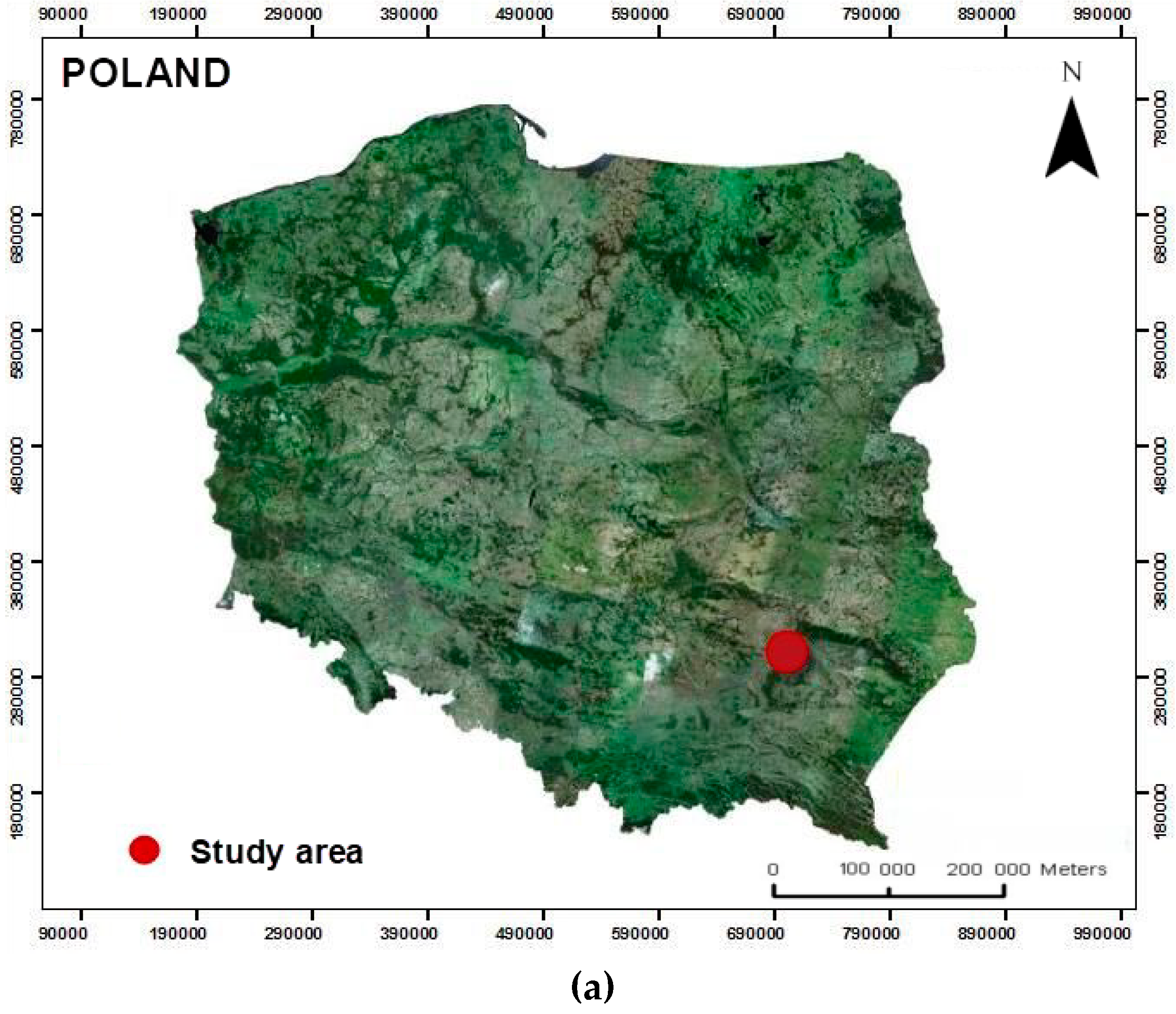
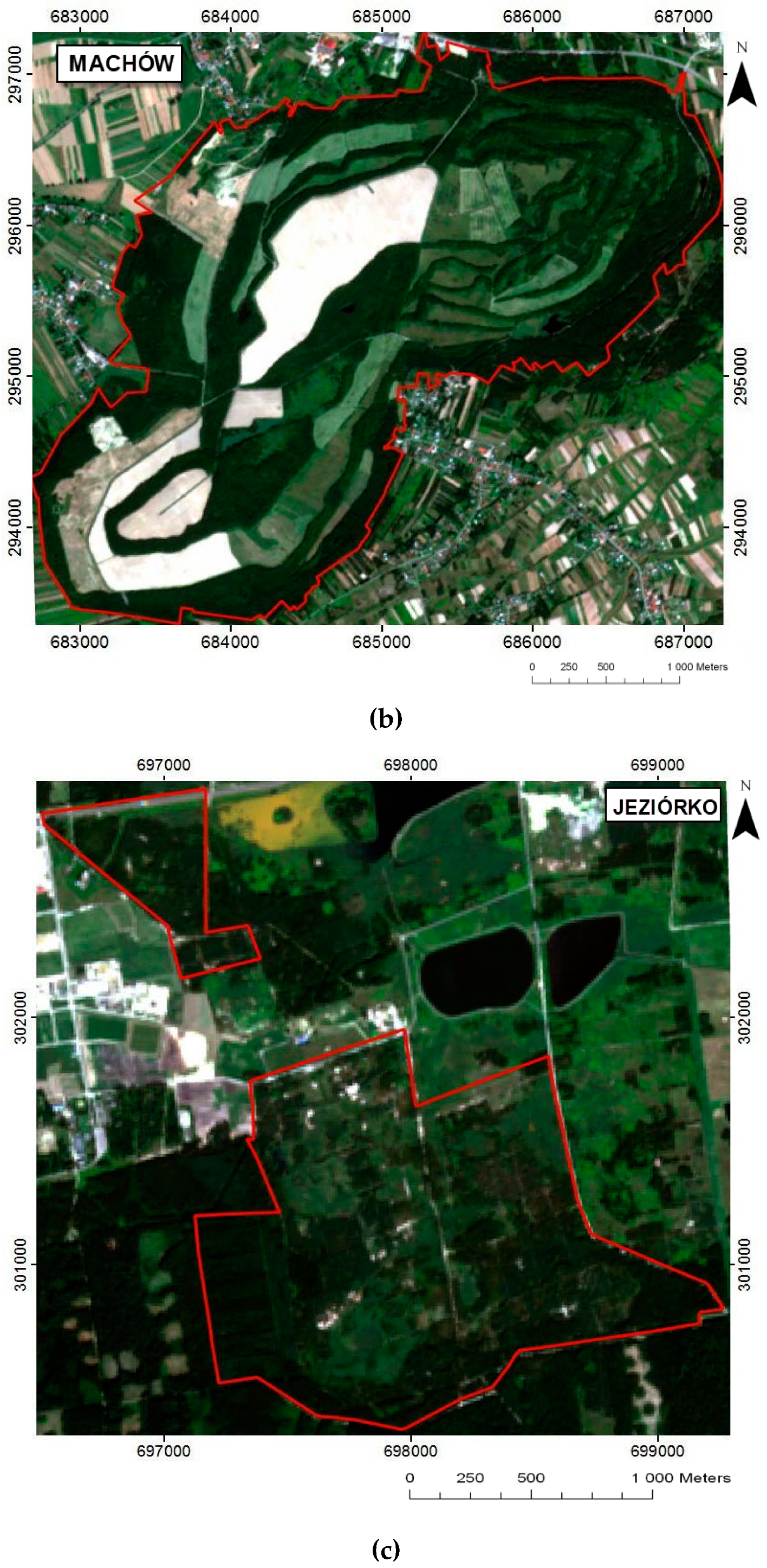
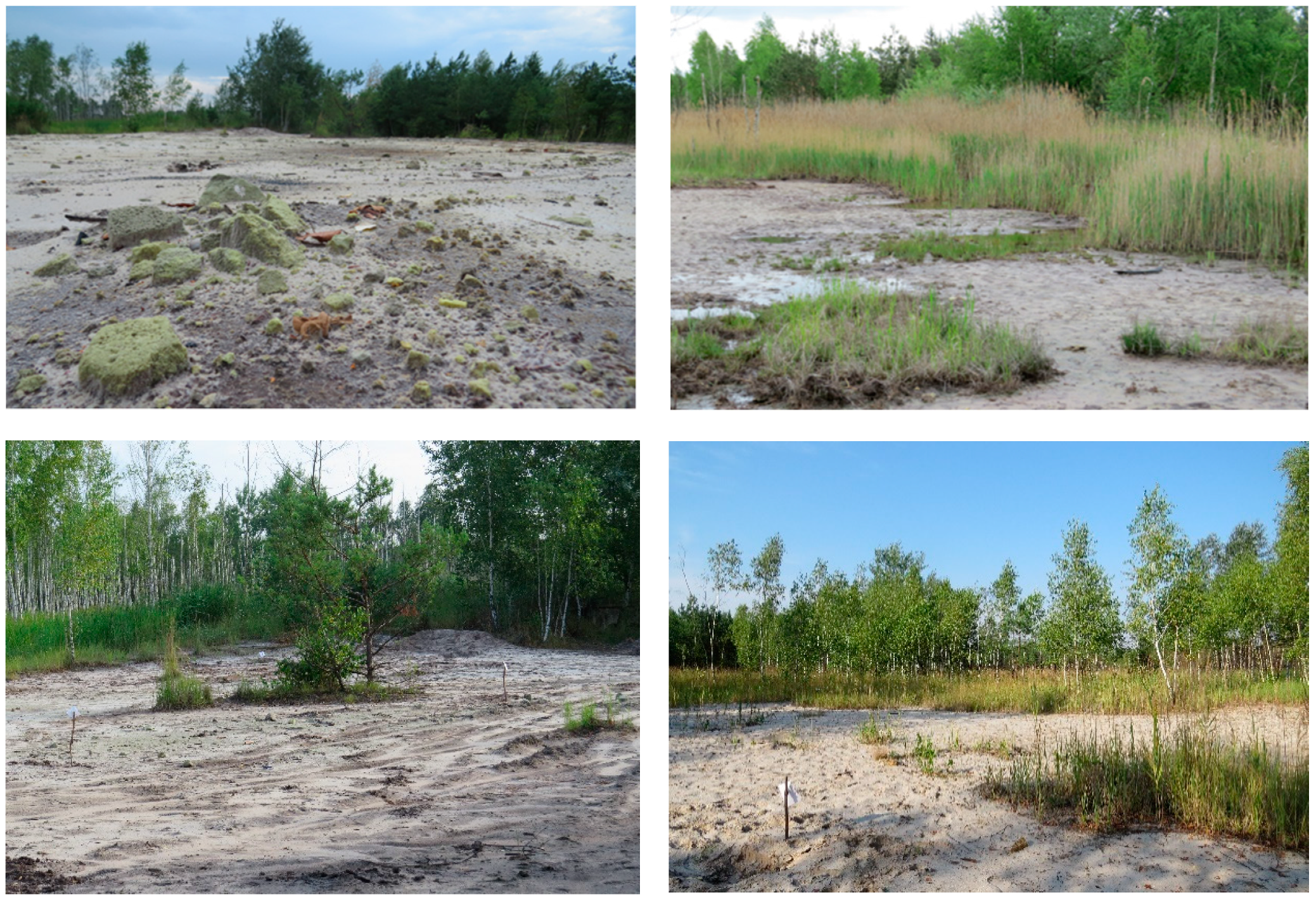
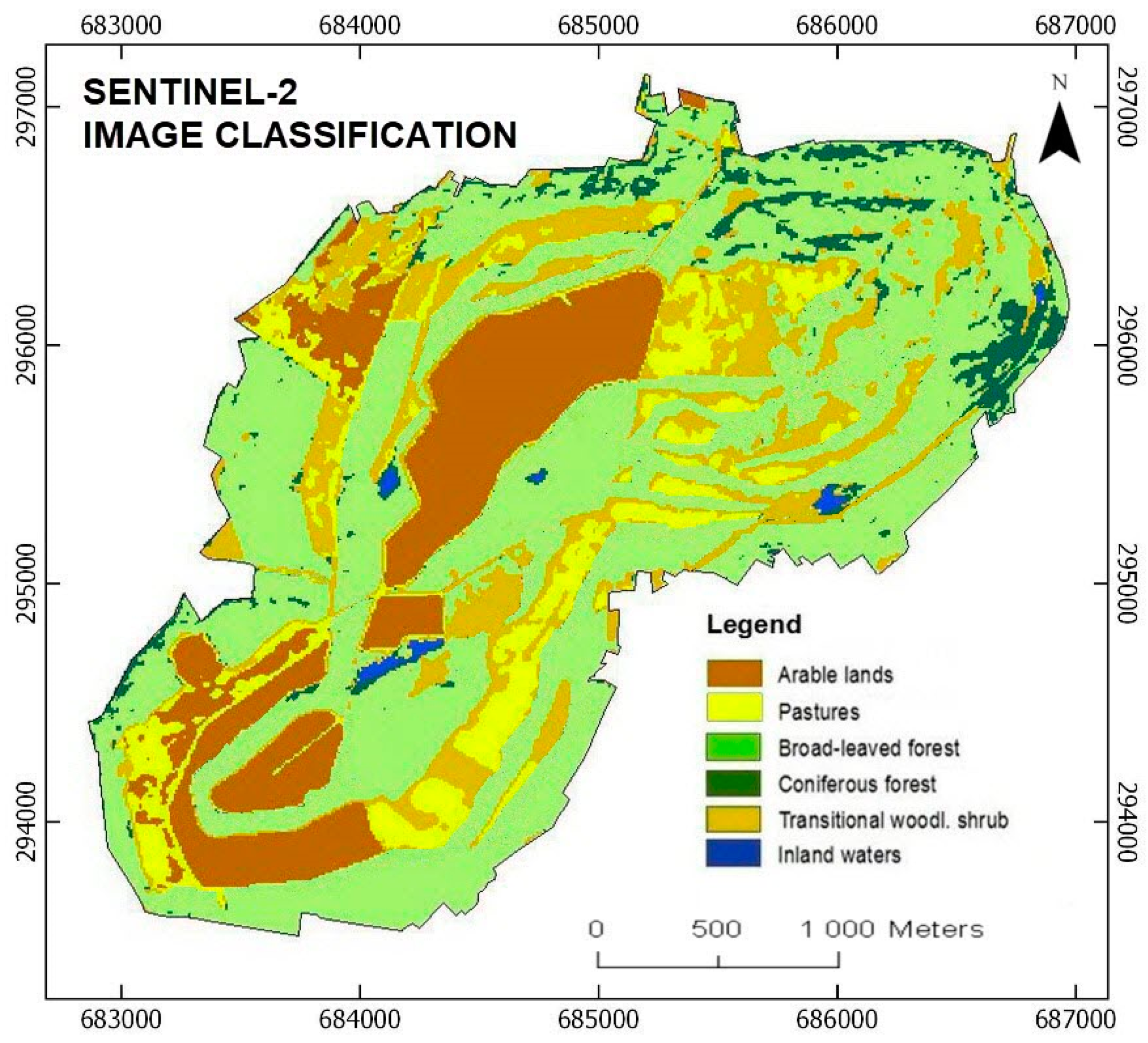
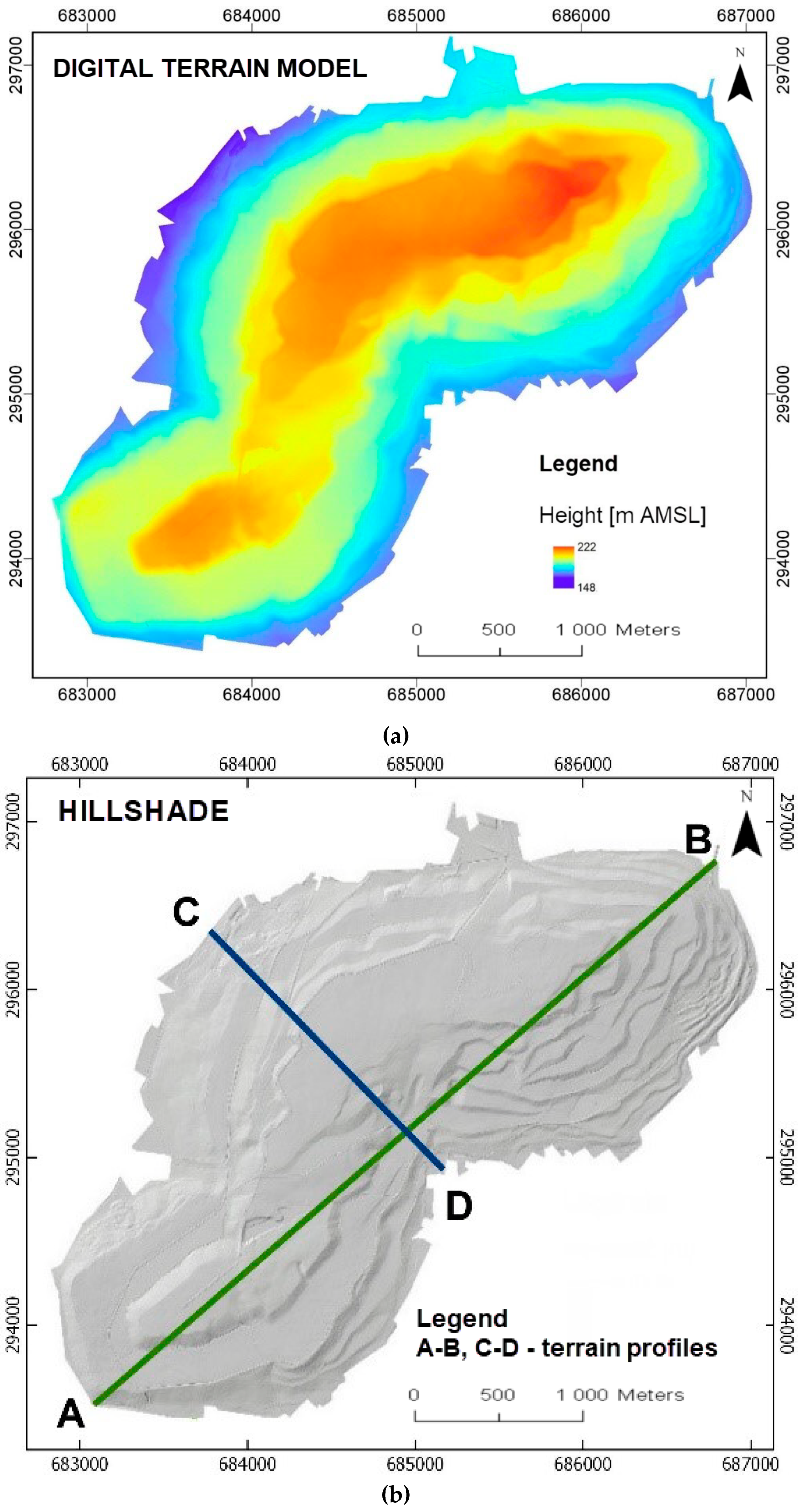
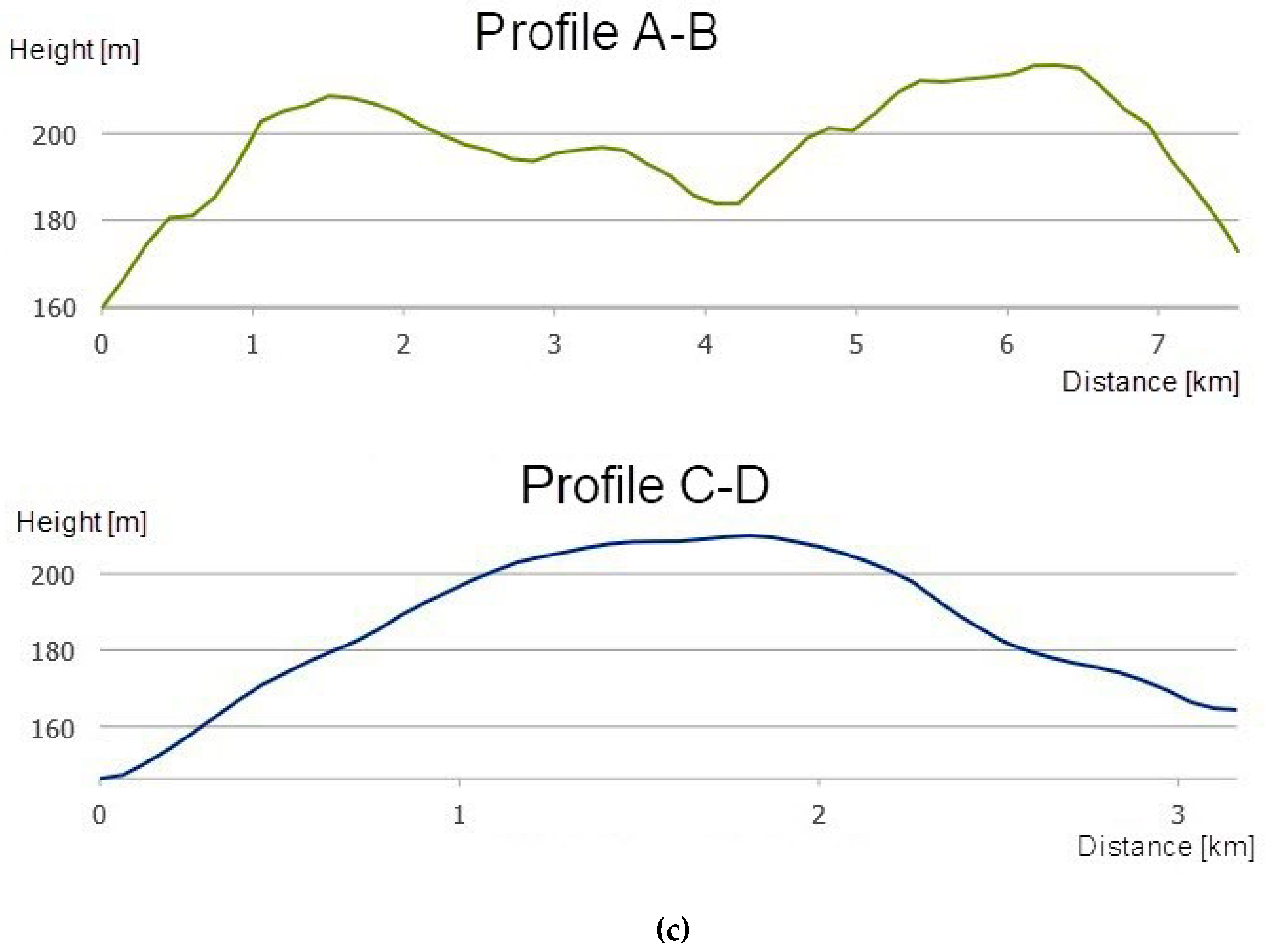
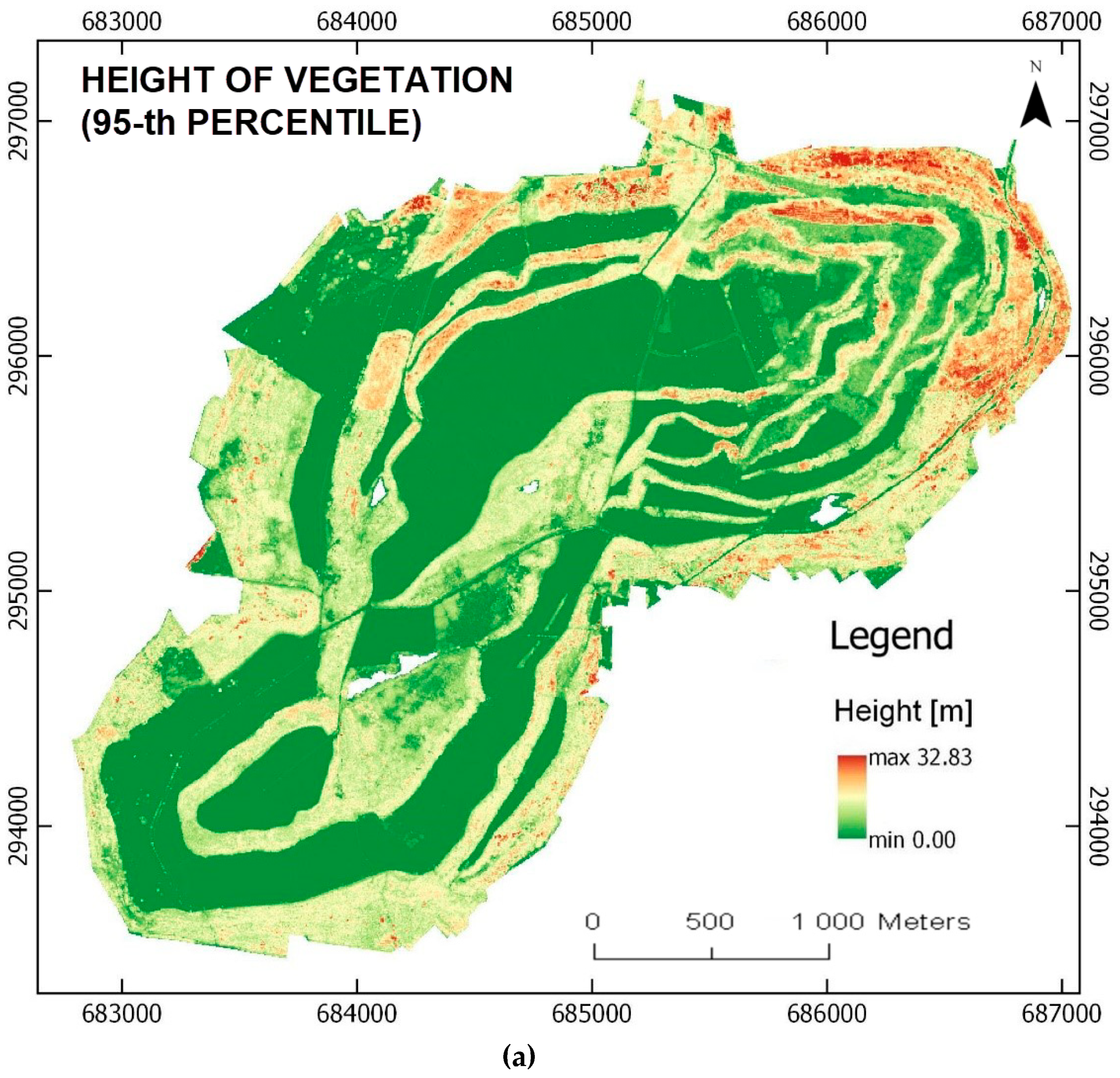
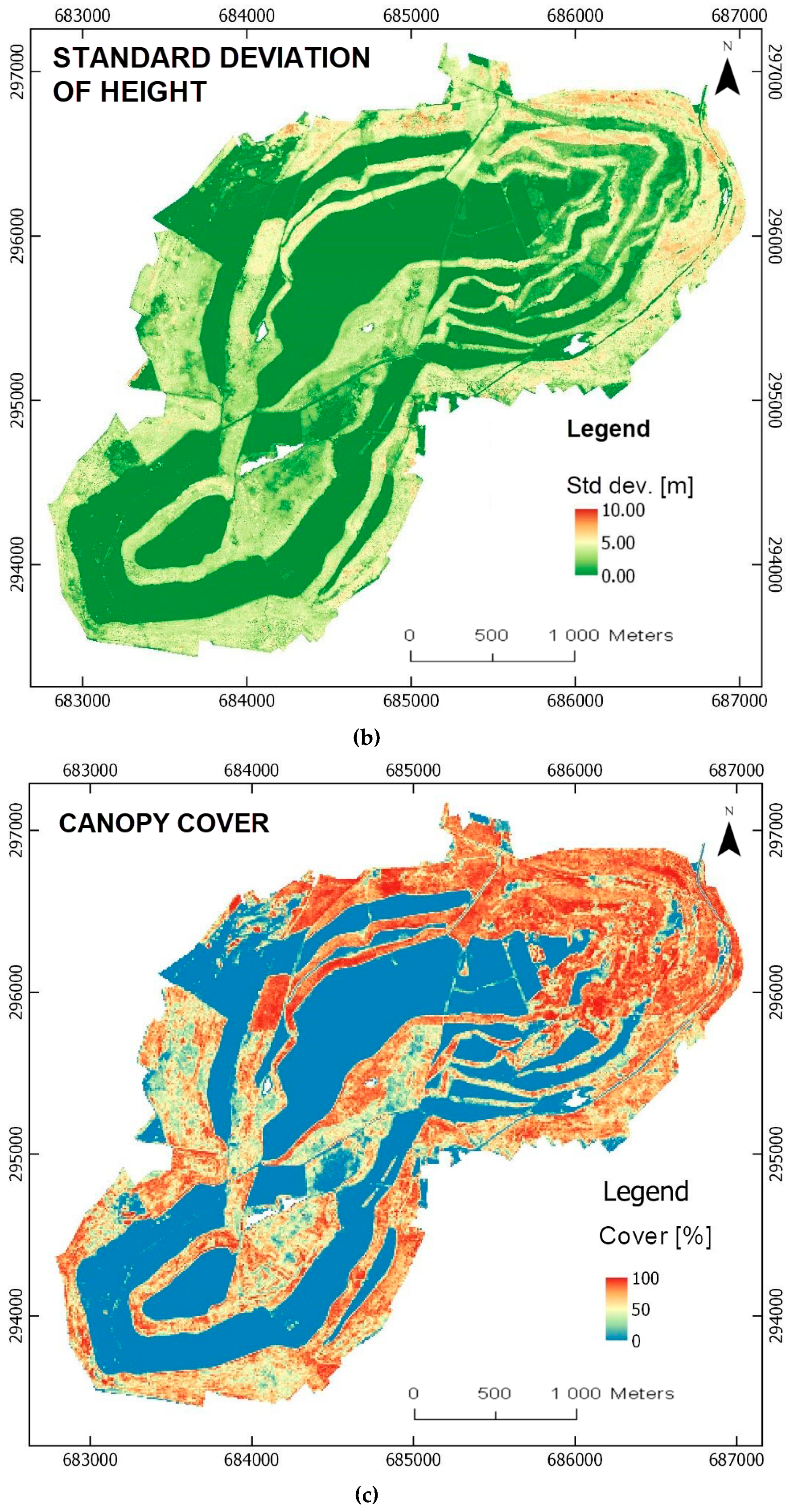
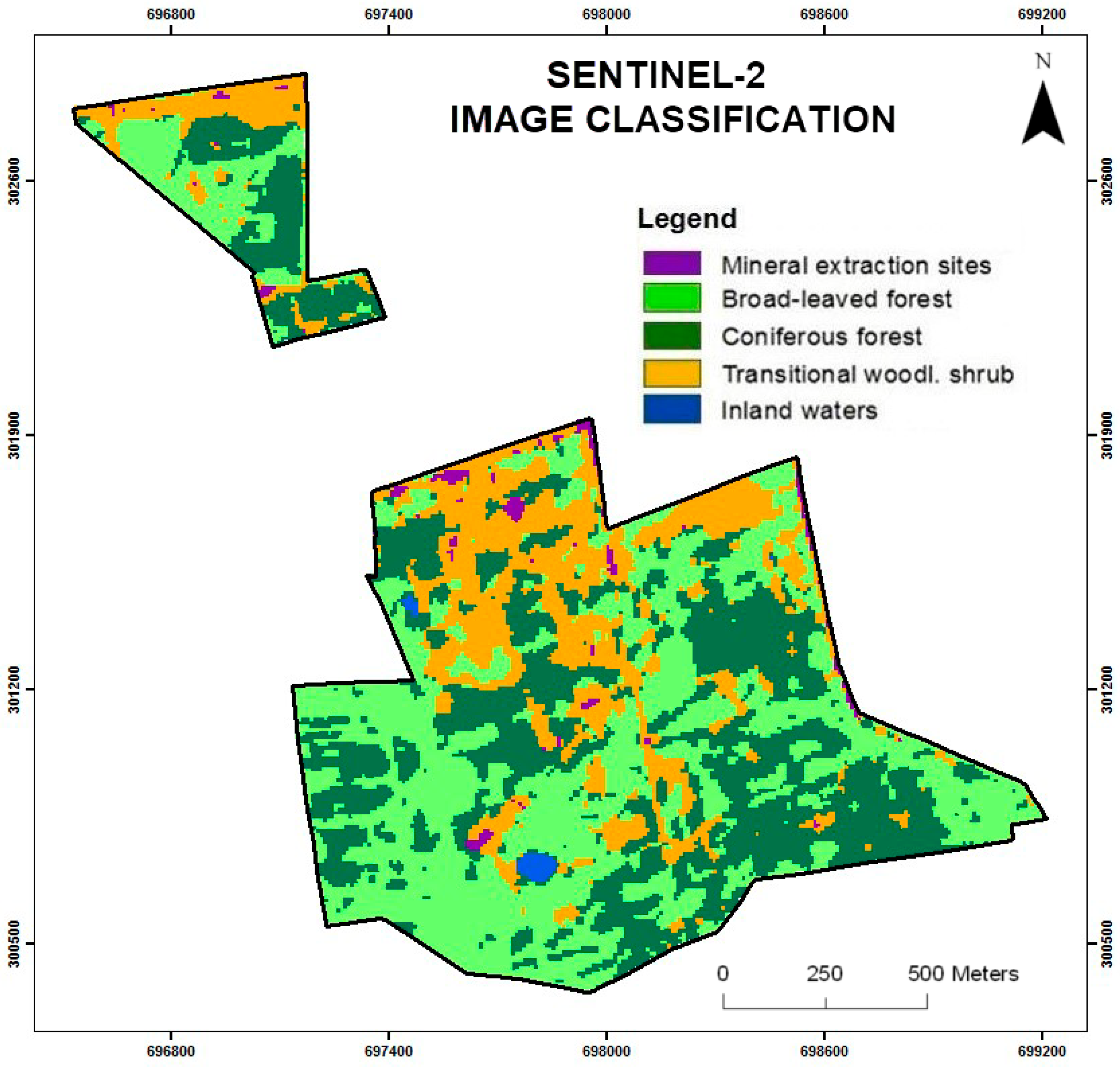
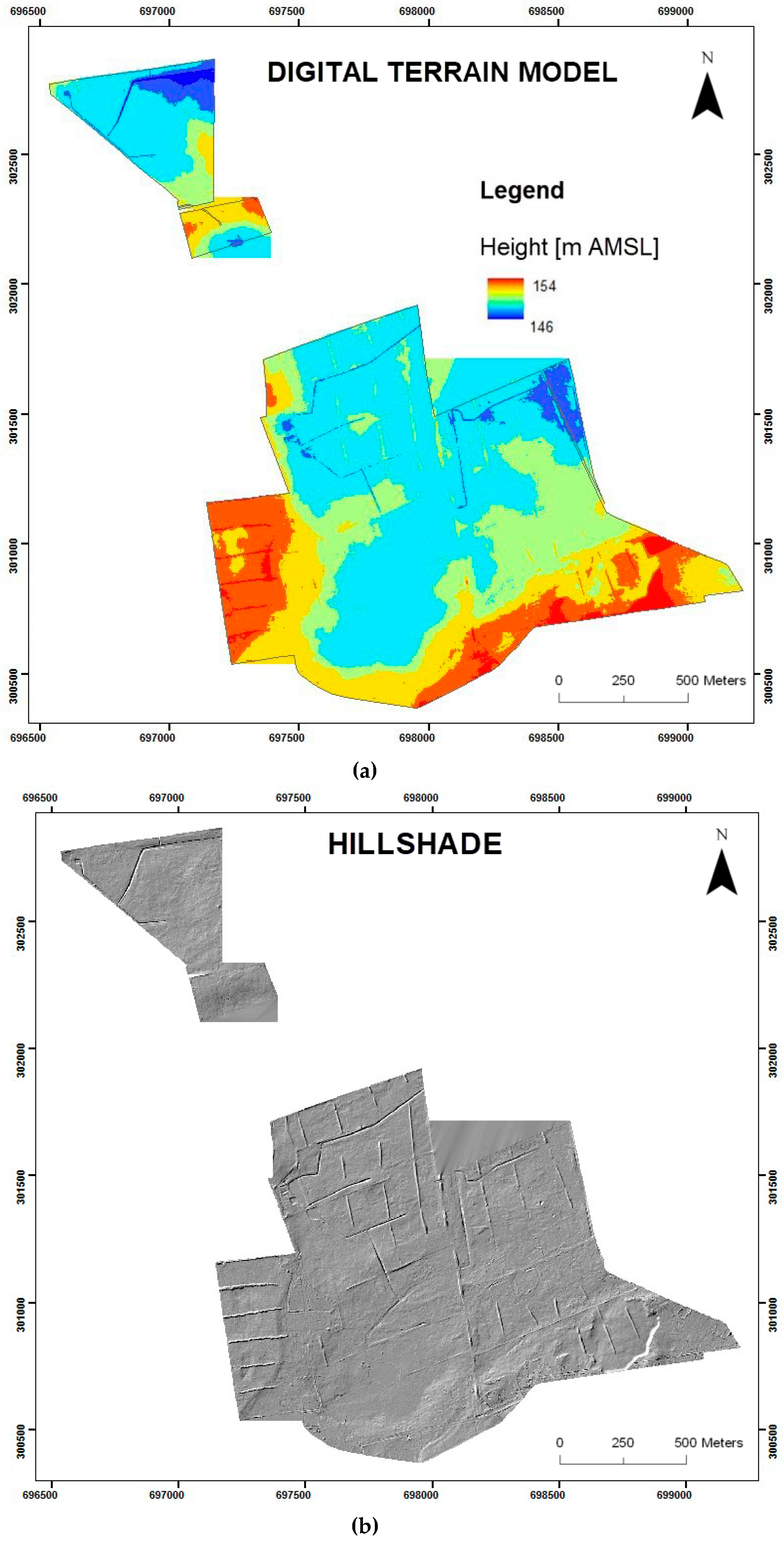
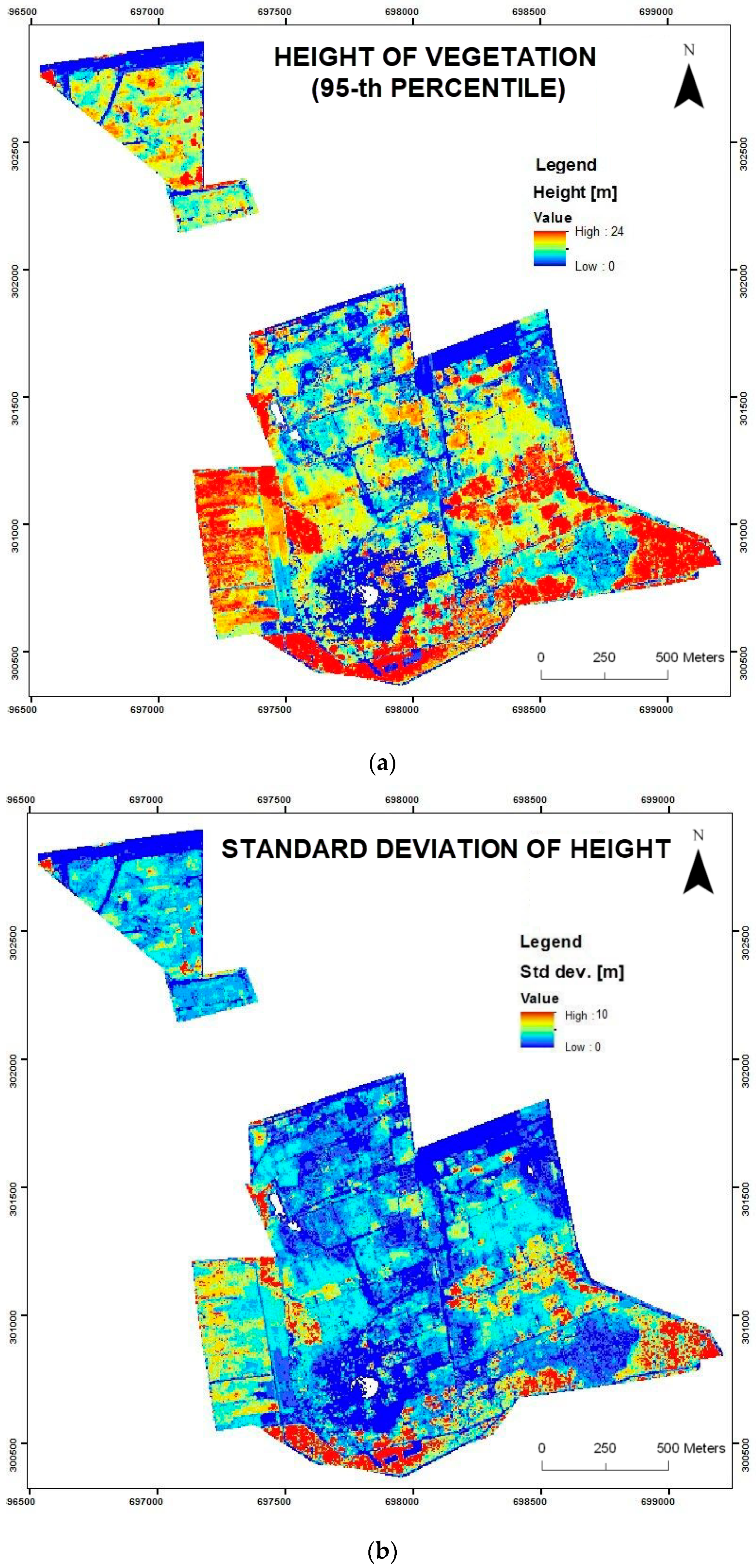
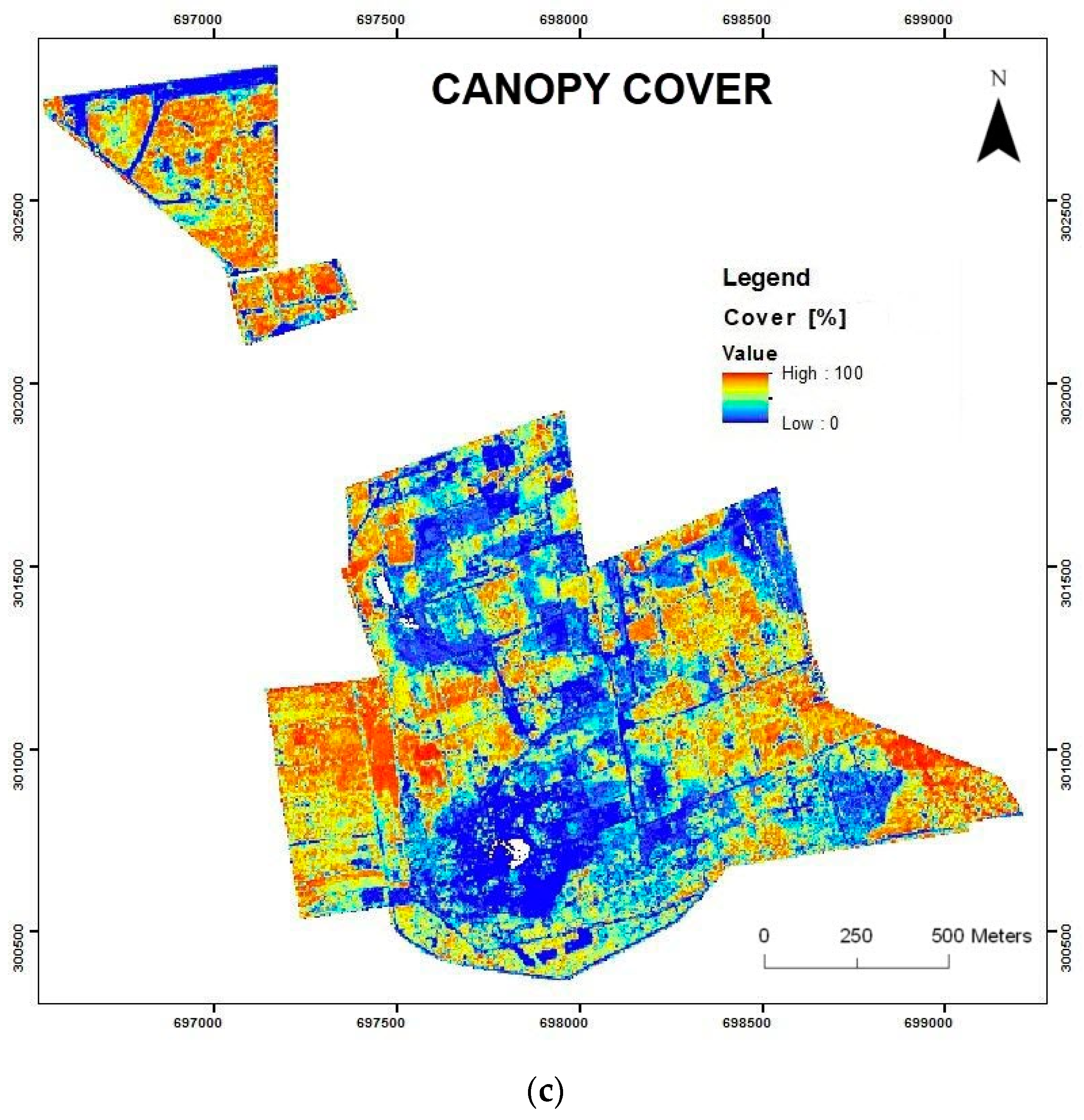
| LULC Classes | Arable Lands | Pastures | Broad-Leaved Forest | Coniferous Forest | Transitional Woodland Shrub | Waters | Accuracy |
|---|---|---|---|---|---|---|---|
| Arable lands | 1112 | 11 | 0 | 0 | 0 | 0 | 0.99 |
| Pastures | 1 | 254 | 0 | 0 | 1 | 0 | 0.99 |
| Broad-leaved forest | 0 | 2 | 443 | 2 | 13 | 0 | 0.96 |
| Coniferous forest | 0 | 1 | 25 | 249 | 0 | 0 | 0.91 |
| T. woodland shrub | 0 | 8 | 0 | 0 | 129 | 0 | 0.94 |
| Waters | 0 | 0 | 0 | 7 | 0 | 130 | 0.92 |
| Reliability | 1.00 | 0.90 | 0.95 | 0.97 | 0.90 | 1.00 |
| LULC Classes | Mineral Extraction Sites | Broad-Leaved Forest | Coniferous Forest | Transitional Woodland Shrub | Waters | Accuracy |
|---|---|---|---|---|---|---|
| M. extraction sites | 44 | 0 | 1 | 33 | 0 | 0.56 |
| Broad-leaved forest | 0 | 134 | 1 | 0 | 0 | 0.99 |
| Coniferous forest | 0 | 2 | 126 | 3 | 0 | 0.96 |
| T. woodland shrub | 4 | 8 | 0 | 57 | 0 | 0.83 |
| Waters | 0 | 0 | 8 | 0 | 213 | 0.96 |
| Reliability | 0.92 | 0.93 | 0.93 | 0.61 | 1.00 |
© 2020 by the authors. Licensee MDPI, Basel, Switzerland. This article is an open access article distributed under the terms and conditions of the Creative Commons Attribution (CC BY) license (http://creativecommons.org/licenses/by/4.0/).
Share and Cite
Szostak, M.; Pietrzykowski, M.; Likus-Cieślik, J. Reclaimed Area Land Cover Mapping Using Sentinel-2 Imagery and LiDAR Point Clouds. Remote Sens. 2020, 12, 261. https://doi.org/10.3390/rs12020261
Szostak M, Pietrzykowski M, Likus-Cieślik J. Reclaimed Area Land Cover Mapping Using Sentinel-2 Imagery and LiDAR Point Clouds. Remote Sensing. 2020; 12(2):261. https://doi.org/10.3390/rs12020261
Chicago/Turabian StyleSzostak, Marta, Marcin Pietrzykowski, and Justyna Likus-Cieślik. 2020. "Reclaimed Area Land Cover Mapping Using Sentinel-2 Imagery and LiDAR Point Clouds" Remote Sensing 12, no. 2: 261. https://doi.org/10.3390/rs12020261
APA StyleSzostak, M., Pietrzykowski, M., & Likus-Cieślik, J. (2020). Reclaimed Area Land Cover Mapping Using Sentinel-2 Imagery and LiDAR Point Clouds. Remote Sensing, 12(2), 261. https://doi.org/10.3390/rs12020261








